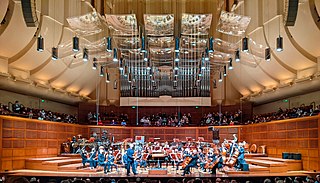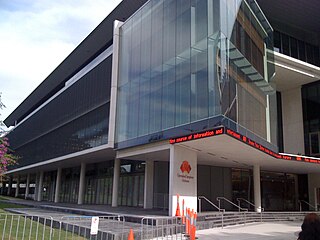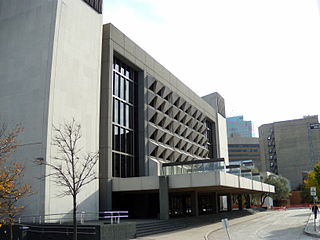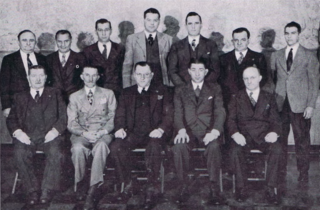
Holyoke is a city in Hampden County, Massachusetts, United States, that lies between the western bank of the Connecticut River and the Mount Tom Range. As of the 2020 census, the city had a population of 38,247. Located 8 miles (13 km) north of Springfield, Holyoke is part of the Springfield Metropolitan Area, one of the two distinct metropolitan areas in Massachusetts.

The San Francisco Symphony, founded in 1911, is an American orchestra based in San Francisco, California. Since 1980 the orchestra has been resident at the Louise M. Davies Symphony Hall in the city's Hayes Valley neighborhood. The San Francisco Symphony Youth Orchestra and the San Francisco Symphony Chorus (1972) are part of the organization. Michael Tilson Thomas became the orchestra's music director in 1995, and concluded his tenure in 2020 when Esa-Pekka Salonen took over the position.

Queensland Symphony Orchestra (QSO) is an Australian symphony orchestra in the state of Queensland. The orchestra is based in the Australian Broadcasting Corporation's building in South Bank. The Orchestra is funded by private corporations, the state government and the Australian federal government through the Australia Council.

Holyoke Community College (HCC) is a public community college in Holyoke, Massachusetts. It offers associate degrees and certificate programs, as well as a transfer program for students to earn credits for transfer to other colleges. It was the first community college established in Massachusetts, as it was founded by the city's school board in 1946, while others were subsequently chartered under state jurisdiction after 1960.

The Oregon Symphony is an American symphony orchestra based in Portland, Oregon, United States. Founded as the 'Portland Symphony Society' in 1896, it is the sixth oldest orchestra in the United States, and oldest in the Western United States. Its home venue is the Arlene Schnitzer Concert Hall in downtown Portland's Cultural District.

The Winnipeg Symphony Orchestra (WSO) is a Canadian orchestra based in Winnipeg, Manitoba. Founded in 1947, the orchestra plays most of its concerts at the Centennial Concert Hall. Including travelling performances, the WSO presents an average of 80 concerts per year, and also provides orchestral accompaniment to the Royal Winnipeg Ballet and the Manitoba Opera.

The San Antonio Symphony was a full-time professional symphony orchestra based in San Antonio, Texas. Its season ran from late September to early June. Sebastian Lang-Lessing, its music director from 2010 to 2020, was the last to serve in that capacity. The orchestra was a resident organization of the Tobin Center for the Performing Arts in San Antonio. In August 2022, the orchestra's musicians reformed as the San Antonio Philharmonic, a name first used in 1914, and announced a ten-concert classical-music series for the 2022–23 season to be given at First Baptist Church of San Antonio, 100 yards from Tobin Center.
The Oklahoma City Philharmonic is an American symphony orchestra in Oklahoma City, Oklahoma.

The Syracuse Symphony Orchestra (SSO) was a 79-member orchestra located in Syracuse, New York. In its time it was the 43rd largest orchestra in the United States and performed a variety of programs including the Post-Standard Classics Series and M&T Bank Pops Series. The orchestra also operated two youth orchestras in the Syracuse area: the Syracuse Symphony Youth Orchestra and the Syracuse Symphony Youth String Orchestra.
The Baton Rouge Symphony Orchestra, founded in 1947, is an orchestra located in Baton Rouge, Louisiana, United States. The orchestra performs at the Theater for Performing Arts in the Baton Rouge River Center.

The Charlotte Symphony Orchestra is an American orchestra based in Charlotte, North Carolina. The orchestra’s principal home is the 1,970-seat Belk Theater of the Blumenthal Performing Arts Center. The official chorus of the orchestra is the Charlotte Master Chorale. The orchestra also serves as the resident orchestra for Opera Carolina and Charlotte Ballet. The Symphony Park amphitheater at SouthPark is home to the orchestra’s Summer Pops concerts.

The Denver Symphony Orchestra, established in 1934 and dissolved in 1989, was a professional American orchestra in Denver, Colorado. Until 1978, when the Boettcher Concert Hall was built to house the symphony orchestra, it performed in a succession of theaters, amphitheaters, and auditoriums. It was the predecessor to the Colorado Symphony, although the two ensembles were legally and structurally separate.

Holyoke High School is a public high school in Holyoke, Massachusetts, United States. Since 2015, the school, along with the district, has been in state receivership and through a series of changes in practices, such as innovative restorative justice disciplinary programs, has seen marked improvement in student retention and graduation rates. In the 2017-2018 school year Holyoke High received higher combined SAT scores than the average for schools in Boston, Worcester, and Springfield.
The Des Moines Symphony (DMSO) is a United States symphony orchestra based in Des Moines, Iowa. The current conductor is Joseph Giunta. Established in 1937 as the Des Moines Civic Orchestra, it performs both Masterworks and Pops concerts as well as Iowa's largest single-day concert event, Yankee Doodle Pops. The orchestra principally performs at the Civic Center of Greater Des Moines in downtown Des Moines.
The Duluth Superior Symphony Orchestra (DSSO) is an American orchestra based in Duluth, Minnesota. Founded in 1932 as the Duluth Civic Orchestra, it became the city's first permanent symphony orchestra. In 2000, it performed the North American premiere of Spring Symphony by Chinese composer Xiao-Gang Ye. Since 1966, the DSSO has performed at the Duluth Entertainment Convention Center (DECC) Auditorium. The orchestra's season runs from September to May each year.

Holyoke Medical Center, formerly known as Holyoke City Hospital, is a full-service, community and regional non-profit medical center located in Holyoke, Massachusetts. Holyoke Medical has 198 beds in the main hospital and runs a comprehensive healthcare system that includes the VNA, River Valley Counseling Center and Western Mass Physician Associates, a physician practice group. The service area for hospital covers Greater Holyoke area, with towns in both Hampshire and Hampden County including Holyoke, Chicopee, South Hadley, Granby, Easthampton, Southampton, West Springfield, and Belchertown.

During the late 19th and early 20th centuries Holyoke saw an influx of Franco-Americans, predominantly French-Canadians, who immigrated to Massachusetts to work in the city's growing textile and paper mills. By 1900, 1 in 3 people in Holyoke were of French-Canadian descent, and a 1913 survey of French Americans in the United States found Holyoke, along with other Massachusetts cities, to have a larger community of French or French-Canadian born residents than those of New Orleans or Chicago at that time. Initially faced with discrimination for the use of their labor by mill owners to undermine unionization, as well as for their creation of separate French institutions as part of the La Survivance movement, this demographic quickly gained representation in the city's development and civic institutions. Holyoke was at one time a cultural hub for French-Canadian Americans; the Saint-Jean-Baptiste Society of America was first organized in the city in 1899, along with a number of other institutions, including theater and drama societies from which famed vaudevillian Eva Tanguay was first discovered, and regular publications, with its largest French weekly newspaper, La Justice, published from 1904 to 1964. The city was also home to author Jacques Ducharme, whose 1943 book The Shadows of the Trees, published by Harper, was one of the first non-fiction English accounts of New England's French and French-Canadian diaspora.

Despite representing a significantly smaller population than their Irish, French, Polish, or Puerto Rican counterparts, in the late 19th century through the mid-20th century, German immigrants predominantly from Saxony and Rhineland played a significant economic, cultural, and political role in the history of Holyoke, Massachusetts. The influx of these immigrants can largely be attributed to a single mill and millworker complex, the Germania Woolen Mills, which formed the basis of the immigrant colony that would make the ward encompassing the South Holyoke neighborhood that with the highest German population per capita, in all of New England by 1875. Along with unionization efforts by the Irish community, Germans would also play a key role in the city and region's socialist labor movements as workers organized for higher pay and improved living conditions in the textile and paper mill economies.

From the beginning of the city's history as the western bank of Springfield, Irish families have resided in and contributed to the development of the civics and culture of Holyoke, Massachusetts. Among the first appellations given to the city were the handles "Ireland", "Ireland Parish", or "Ireland Depot", after the village was designated the 3rd Parish of West Springfield in 1786. Initially occupied by a mixture of Yankee English and Irish Protestant families, many of whom belonged to the Baptist community of Elmwood, from 1840 through 1870 the area saw a large influx of Irish Catholic workers, immigrants to the United States, initially from the exodus of the Great Famine. During that period Irish immigrants and their descendants comprised the largest demographic in Holyoke and built much of the early city's infrastructure, including the dams, canals, and factories. Facing early hardships from Anti-Irish sentiment, Holyoke's Irish would largely build the early labor movement of the city's textile and paper mills, and remained active in the national Irish nationalist and Gaelic revival movements of the United States, with the Holyoke Philo-Celtic Society being one of 13 signatory organizations creating the Gaelic League of America, an early 20th century American counterpart of Conradh na Gaeilge.
As of the 2010 United States Census, there were 39,880 people, 15,361 households, and 9,329 families residing in the city of Holyoke, Massachusetts. The population density was 723.6/km2 (1,874/mi²). There were 16,384 housing units at an average density of 277.2/km2 (718.6/mi²).
















